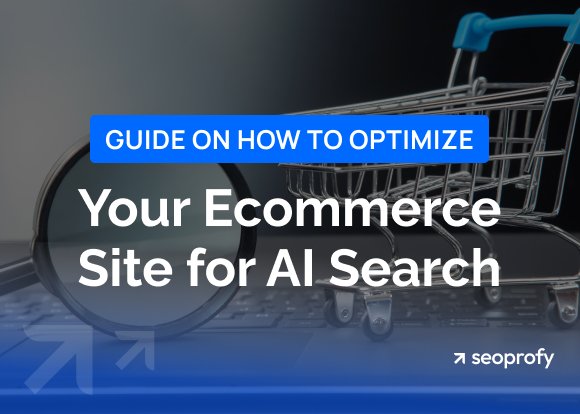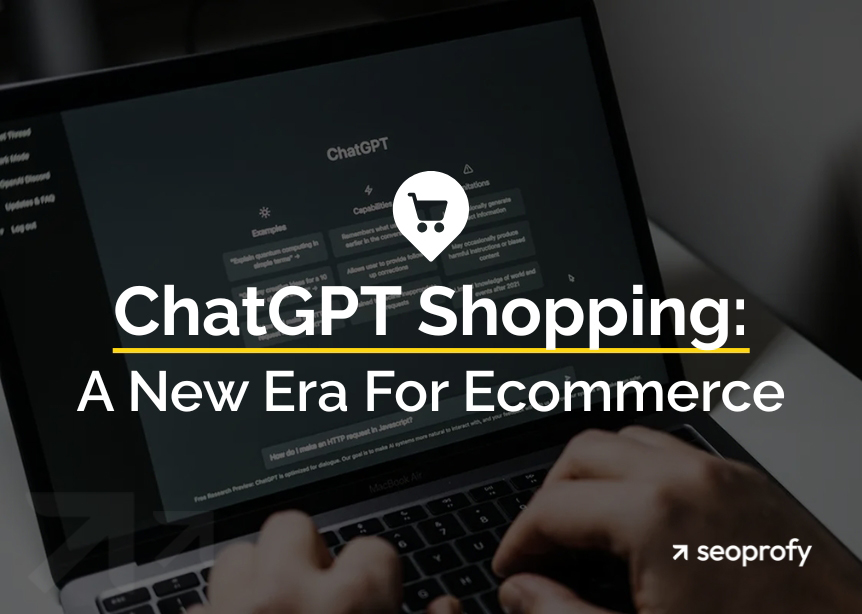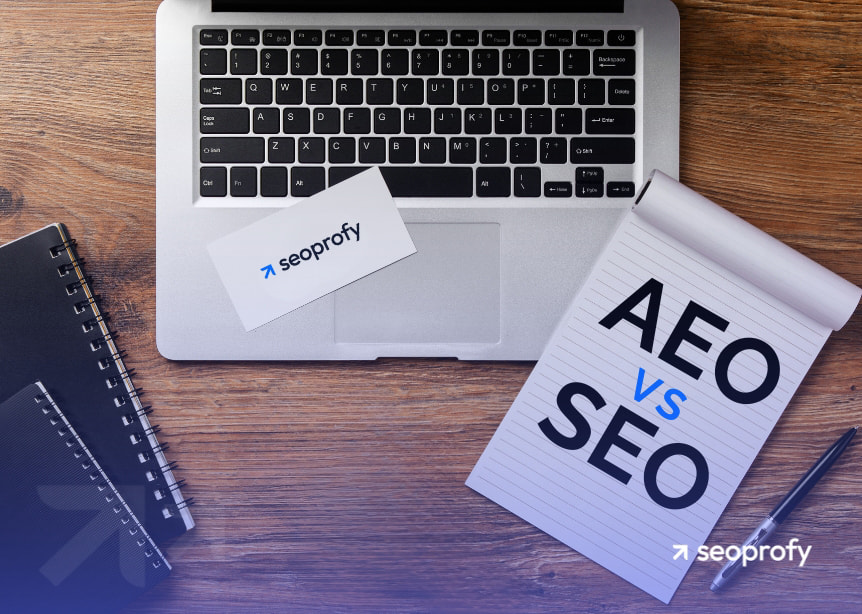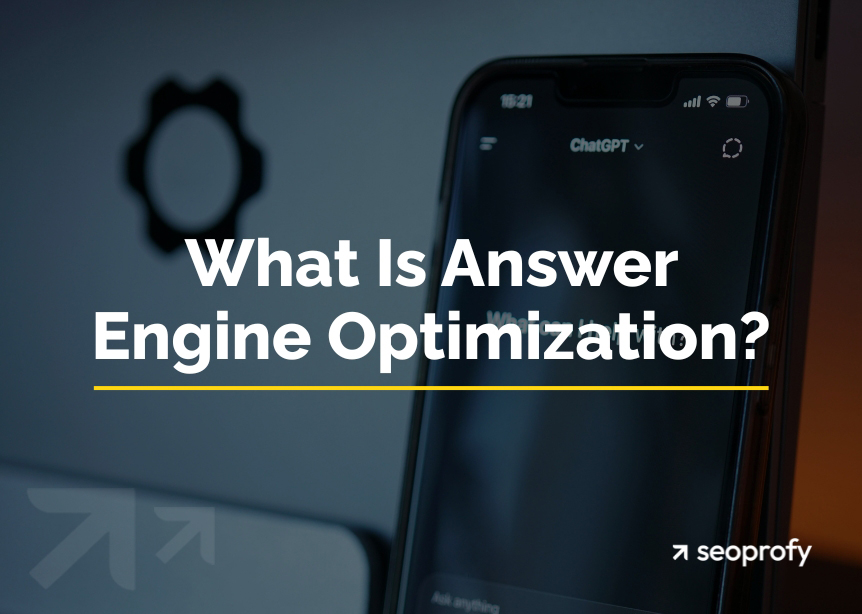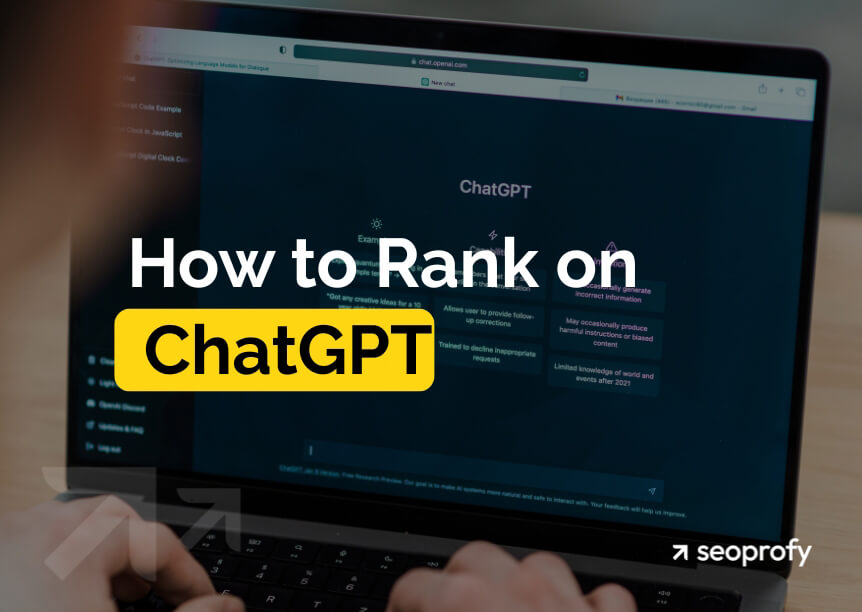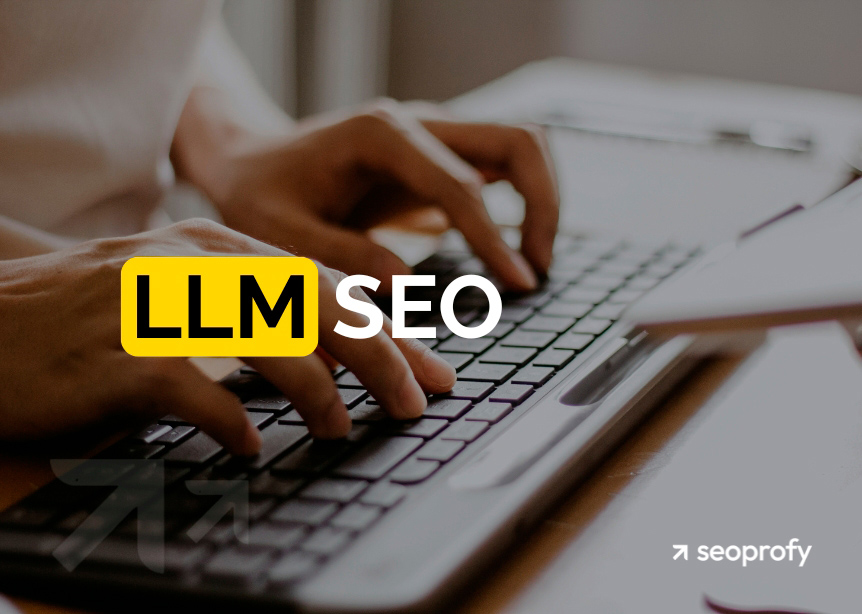Optimizing an ecommerce site for AI search means publishing clear, detailed content that directly addresses user queries, using schema markup effectively, and keeping technical SEO in order. Prioritize user intent and strong E-E-A-T signals such as expertise and trust, while building wider brand visibility online so AI systems view your business as a reliable authority.
Now that you see the bigger picture, you probably crave more details. We wrote this article to share a clear and professional perspective on how to optimize ecommerce websites for AI-driven searches. Each insight is based on tested results from real projects.
- AI search is already changing how people shop, so showing up in Google AI Overviews, ChatGPT, or Perplexity is just as important as ranking in Google.
- Top-of-funnel traffic is shrinking, which means the real wins now come from mid- and bottom-funnel keywords that drive actual sales.
- Brands that go deep into their category with clusters, expert voices, and real customer input are the ones AI engines trust and cite.
- Tracking AI mentions and testing new formats early is the only way to stay ahead while competitors keep trying to catch up.
Why Optimize Your SEO for AI Search?
Search has become complex. Classic rankings in Google are no longer enough because users now treat AI responses as an alternative search engine. More than 71% of people already report using AI tools for search, 14% use them daily, and over 20% have switched their primary search platform within the last year.
If your brand does not rank in AI search results, you are simply not in the places where decisions are made. So, while 19% of marketers plan to build an SEO approach for generative AI search in 2025, the following years will almost certainly bring even stronger growth.
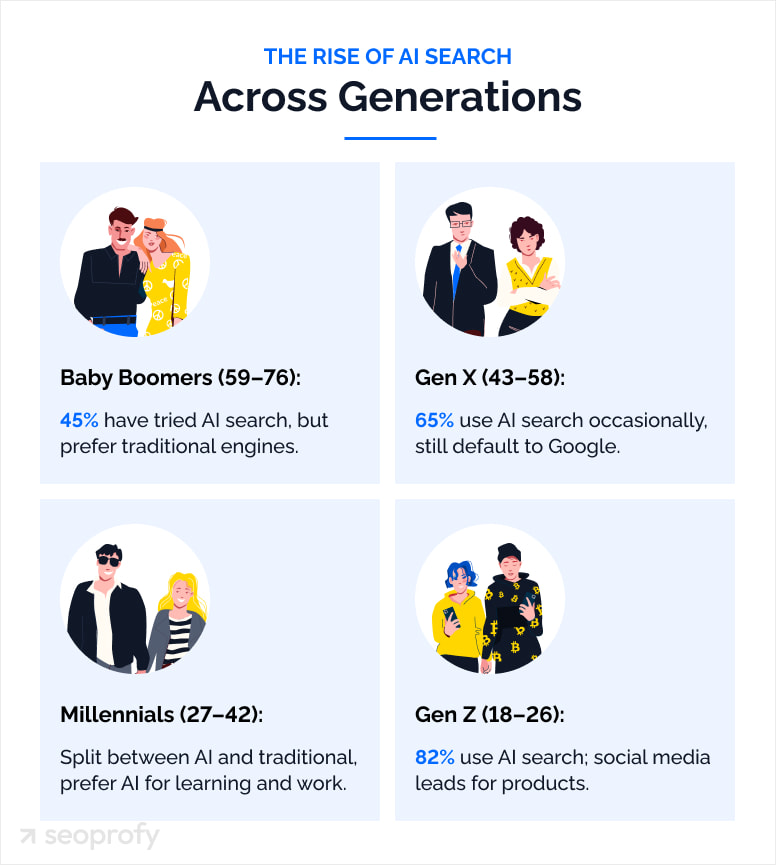
Generational adoption makes this shift even clearer:
- Baby Boomers (59–76): 45% have tried AI search but remain most loyal to traditional engines.
- Gen X (43–58): 65% use AI search occasionally yet still default to Google.
- Millennials (27–42): Split their behavior between AI and traditional search, leaning on AI especially for education and career queries.
- Gen Z (18–26): 82% use AI search at least occasionally. At the same time, they lean heavily on social media for product discovery.
The adoption curve across generations makes it clear that no single channel can cover everyone. If your main buyers are Millennials or Gen Z, both AEO and social discovery are critical. If your buyers are Gen X or Boomers, you cannot ignore traditional SEO while gradually adding AI visibility.
How SGE is Changing Ecommerce Search Visibility
For ecommerce businesses, the urgency of optimizing for AI-driven answers may be even higher than for other niches. Reports already show traffic drops of up to 30% in some verticals as “brave new search” takes clicks away from organic results. The flipside is that brands adapting quickly are seeing new growth from these same channels.
Adobe Analytics data shows just how sharp the shift is. Generative AI referrals to retail sites rose by 1,300% during the 2024 holiday season compared to the year before, and growth did not stop after the holidays. By February 2025, generative AI traffic to retail was up 1,200% compared to July 2024, with travel spiking by 1,700% and banking also up 1,200%. The chart below illustrates how fast customer behavior is changing, doubling roughly every two months since late 2024:
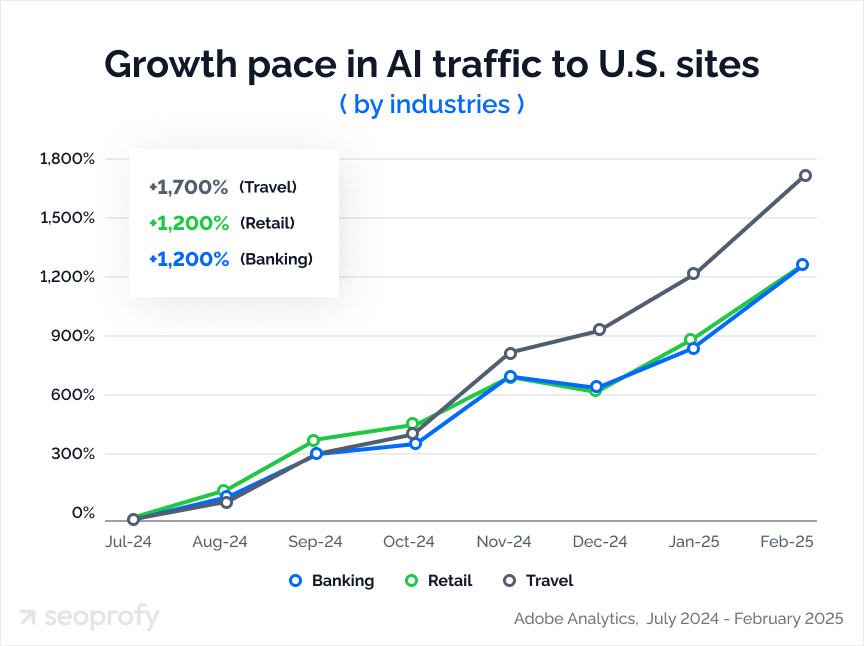
But we are seeing changes, not just in clicks, but in several other aspects. For example, users are increasingly moving from short keyword queries to conversational phrasing. Instead of typing “buy running shoes,” they now ask, “What are the best running shoes for flat feet under 200 dollars?” This shift changes which pages appear in AI Overviews and what ChatGPT selects.
Another noticeable change is the rise of zero-click searches. More and more people get a complete answer inside an AI Overview or a chat window, and never move on to a website.
Here is a simple experiment. Imagine a shopper choosing between the Canon G7X Mark II and the Sony ZV-1. These are not professional cameras but models for a mass audience. Such a buyer is unlikely to dig into dozens of technical specifications. A short summary in an AI Overview with pros and cons is often enough to make a decision. As a result, for this type of query, the number of clicks to websites decreases because the AI answer already feels sufficient.
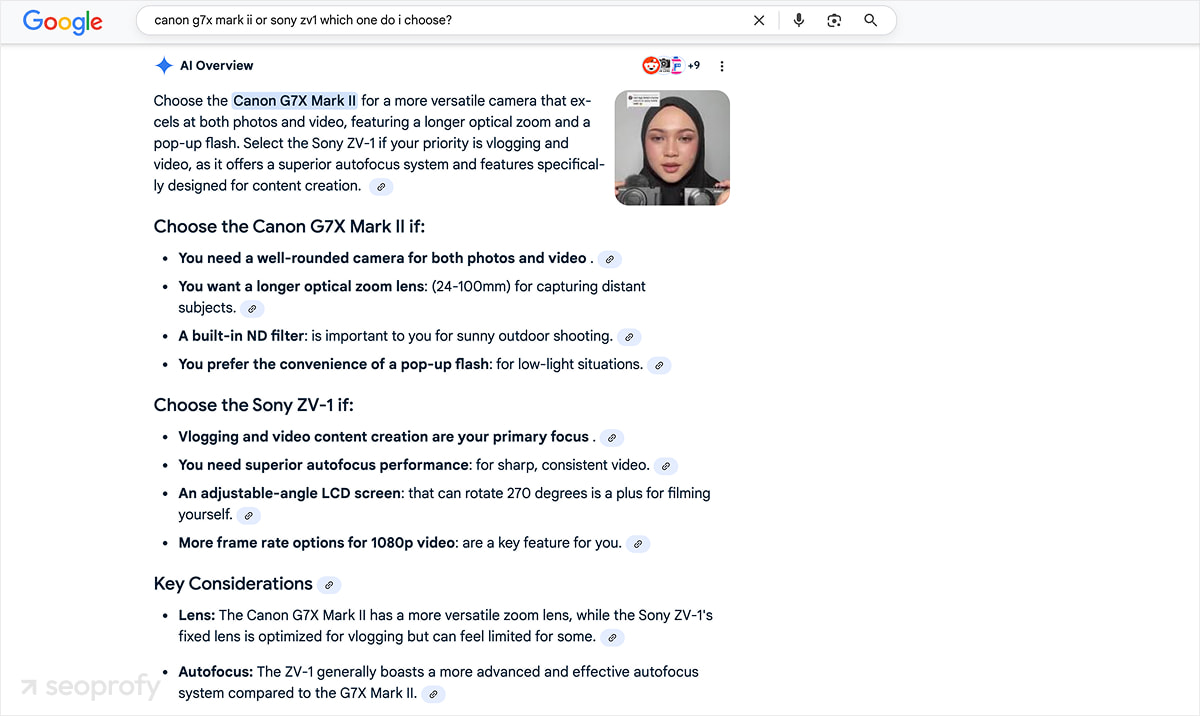
In LLM SEO, this is not a universal rule for every product. In categories with higher prices or complex features, people are still more likely to click through to compare details, read reviews, or check specifications. So, each business has to look at its own category and see where AI answers replace clicks, and where they actually drive more of them.
What Challenges Ecommerce Brands Face with AI Search Shift
Ecommerce brands are seeing uneven effects from the rise of AI search. Some types of queries are heavily disrupted, while others remain more stable:
- Informational queries are losing ground: AI systems now cover many top-of-funnel searches such as “best running shoes 2025” or “how to clean leather boots,” which reduces traffic to e-commerce blogs and guides.
- Limited effect on transactional queries (at least, for now): Direct purchase searches like “buy Nike Air Max size 42” are still less influenced by AI, since engines often pass these straight to product pages.
- Competitive pressure inside AI Overviews: Even when clicks still happen, brands are competing to be named in AI answer boxes, where visibility itself builds trust and captures intent.
What Opportunities Does Getting into AI Answers Give
So, after all the context and the challenges that AI in ecommerce SEO comes with, the natural question is, what do we actually gain if we manage to get into AI answers? The truth is there are several practical upsides that go far beyond just “extra visibility.”
- Being cited builds trust: When your brand name shows up in an AI summary, people see you as a source worth listening to. Even if they do not click, that visibility sticks and builds authority over time. For instance, if an AI Overview compares Nike Air Max vs Adidas Ultraboost and cites Nike’s official store as the source, that mention alone can influence the shopper’s perception.

- Room for authority-driven content: AI engines are hungry for content that looks like it comes from real expertise (especially with tons of shallow AI-generated content out there). Brands that can share actual know-how and experience stand out much faster than those that only push generic product pages.
- Transactional SEO is still strong: Product and conversion-focused queries are not disappearing. If anything, they are becoming easier to capture because AI results often send users straight to the place where they can buy.
How to Adapt Ecommerce SEO for AI
Now let’s move on to the most exciting part: optimizing ecommerce websites for AI search results. Our team has been testing approaches since these technologies first started to appear and has built strategies that consistently deliver. In ecommerce, we see some of the clearest returns, from visibility gains to direct sales growth. It is the right moment to share what actually works so you can apply it too (or get our ecommerce SEO agency to make your website more visible).
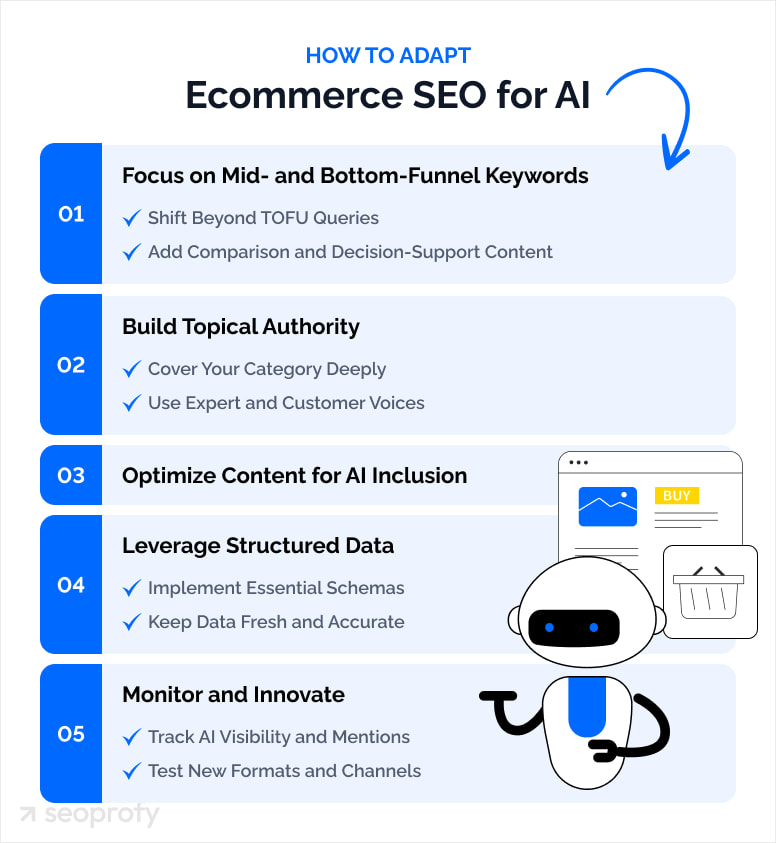
Focus on Mid- and Bottom-Funnel Keywords
Shift Beyond TOFU Queries
Since informational traffic is shrinking, brands doing AI SEO for ecommerce need to invest more effort into mid- and bottom-funnel keywords that lead directly to transactions. Top-of-funnel searches like “how to style summer outfits” may still bring some visibility, but they rarely convert in AI-driven environments.
And while Perplexity and Google’s AI Overviews still show links to the sources they cite, ChatGPT mostly relies on its own memory for informational queries, so earning visibility in those answers is next to impossible.
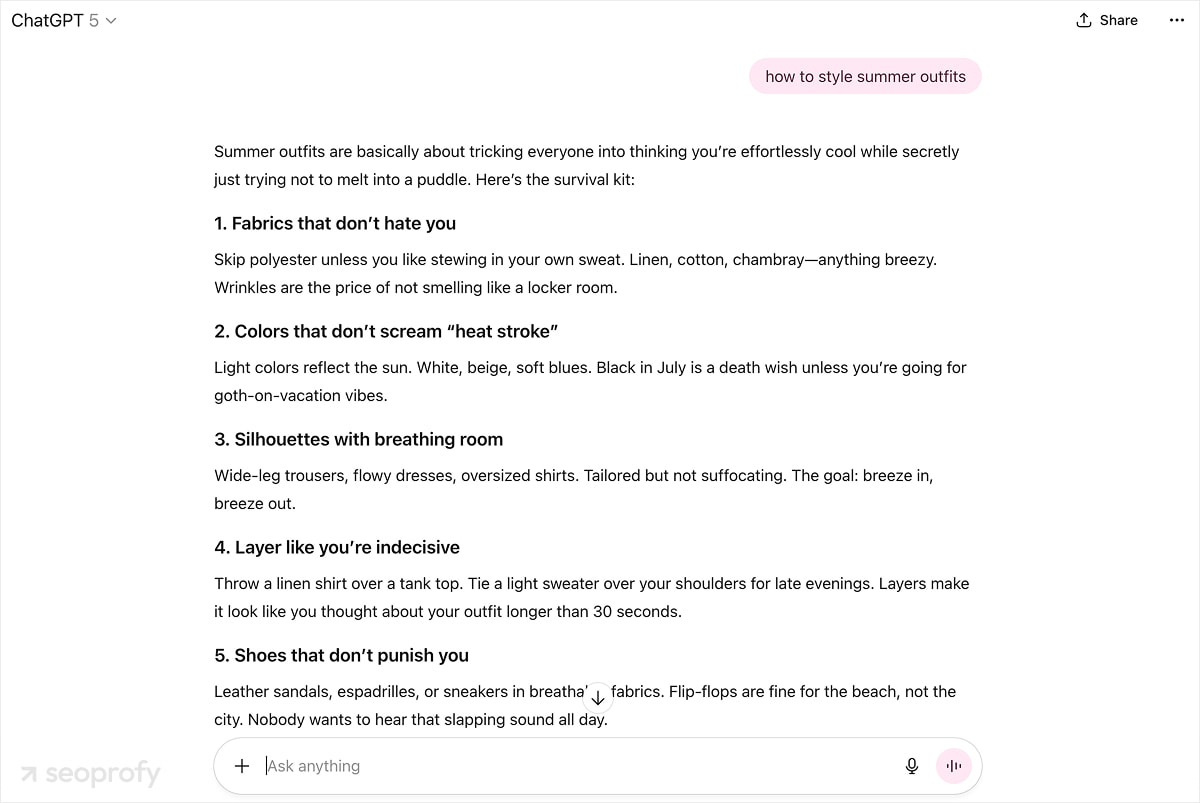
So, ecommerce keyword research can get tricky here. Queries such as “women’s linen blazer under 150” or “best carry-on suitcase with spinner wheels” are far more valuable because they align with strong purchase intent. These are the searches where AI engines are more likely to surface direct product recommendations, and if your site is not optimized here, competitors will capture that demand.
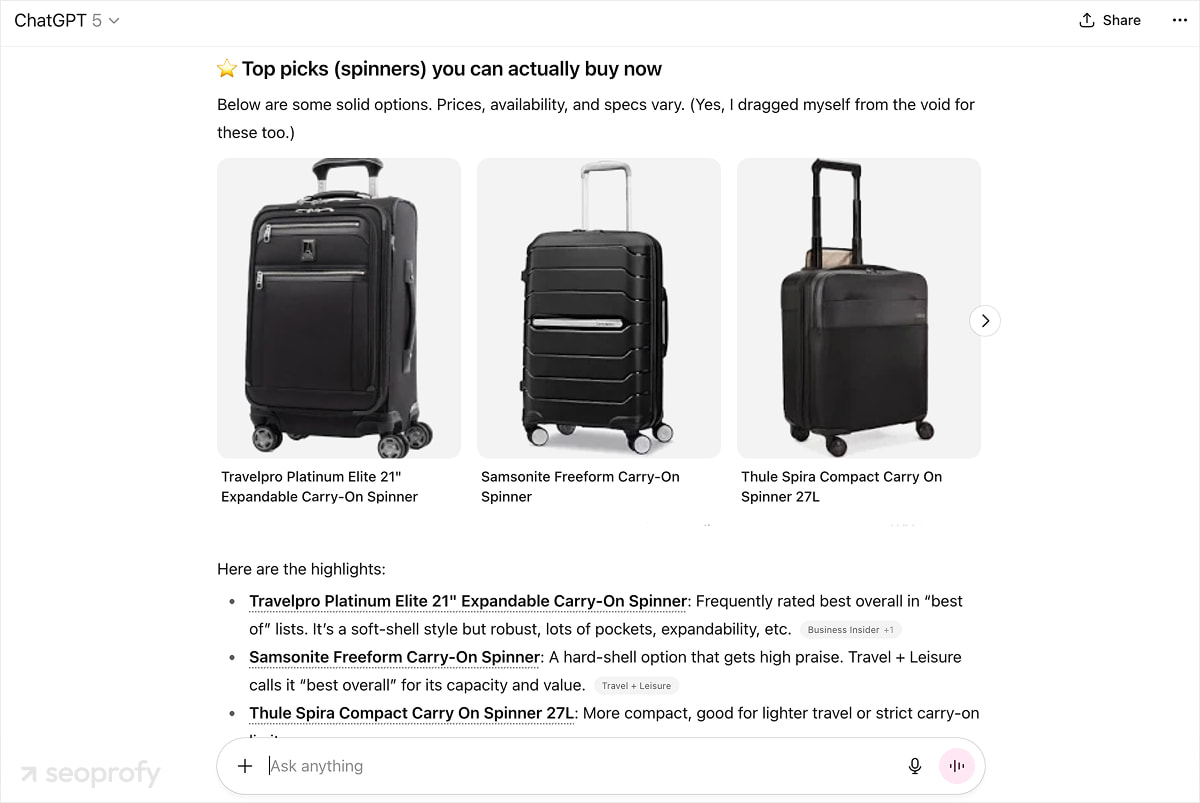
Add Comparison and Decision-Support Content
AI-powered search engines favor answers that simplify decisions, especially when users are already close to buying. Build detailed “product vs product” breakdowns, “best under $X” lists, and feature comparison tables that highlight the differences buyers actually care about. AI results frequently pull from this type of structured, side-by-side content, since it helps resolve buyer uncertainty.
Build Topical Authority
Cover Your Category Deeply
Topical authority in AI-driven SEO for ecommerce comes from a clear content architecture. The first step is to map out the real questions people ask in your category. Use Ahrefs or Semrush to export long-tail keywords for AI mentions in ecommerce SEO and filter for modifiers like best, vs, for [need], under $X. GSC helps confirm what queries you already show up for but fail to convert. Group all this into clusters that reflect different buying stages.
Take skincare as an example. Instead of one moisturizer article, create a hub page that links to focused guides: moisturizers for oily skin, for sensitive skin, with retinol, with hyaluronic acid, under 30 dollars, and so on. Each of those subpages should answer the query directly and then connect back to the hub. Take the skincare brand CeraVe as an example. Their content hubs are now earning them visibility in AI-driven answers.
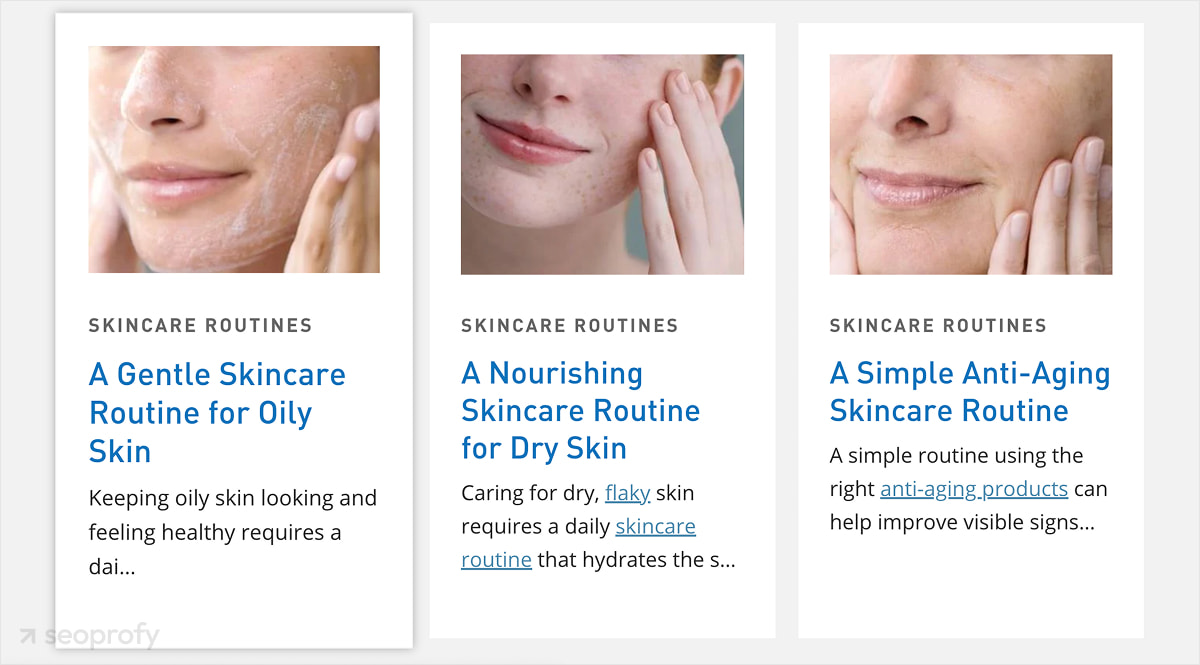
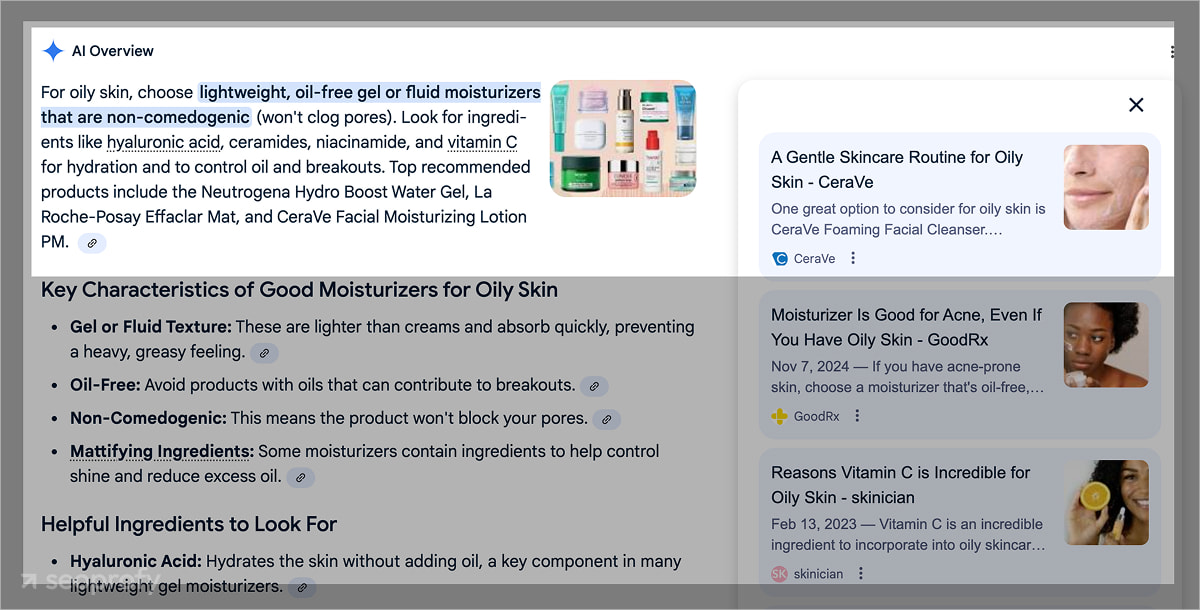
Use Expert and Customer Voices
Authority does not come only from publishing more content. AI systems look for signals that prove your brand is backed by real expertise and trusted by users. Bring in dermatologist commentary, fitness trainer advice, or tech specialist quotes, depending on your niche. Highlight verified customer reviews and encourage user-generated content such as photos and unboxing videos.
These elements strengthen EEAT signals (just as important for traditional search engines). When engines decide between two similar sources, the one with authentic expert and customer input usually wins.
Returning to CeraVe, here’s another good move. For acne (a medical condition) content, they include expert input from a doctor to make the piece more reliable (and Google rewards them with AI Overview mentions).

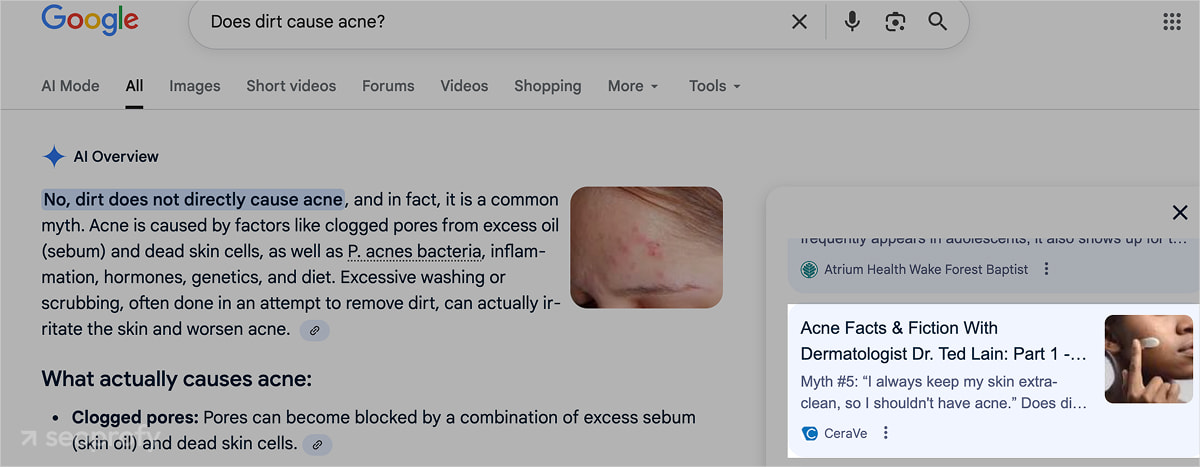
Optimize Content for AI Inclusion
Technical SEO for ecommerce starts with making sure AI engines can process your content quickly, since they read in chunks or, more precisely, in fixed token counts. So, one of the easiest tips for ecommerce AI SEO we can give: provide them with a short, self-contained answer right under the H1. Think 40–60 words that explain the core point without fluff. From there, the page should flow through clear H2 and H3 sections that line up with the questions users actually ask (problem-solution content).
Note: Tokens are the basic units AI uses to process text (roughly 3–4 characters in English). You can check token counts with tools like OpenAI Tokenizer. GPT (and Perplexity built on GPT-4 / Claude) handles up to 200k. Google AI Overviews don’t disclose limits, but research suggests they work in smaller windows (often 4k–8k tokens per chunk).
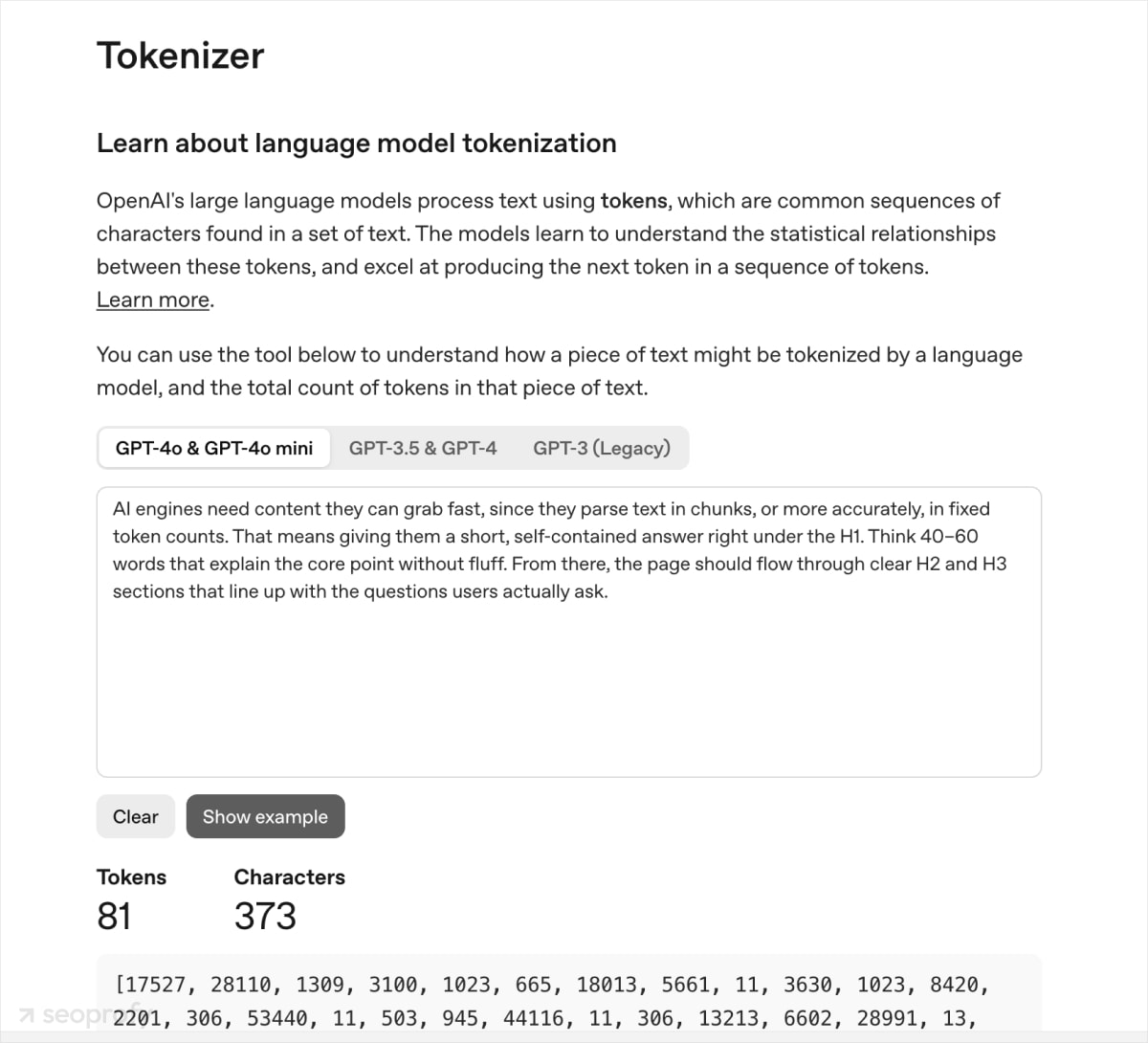
Bullet lists and numbered steps are now real ecommerce SEO trends: engines can lift them as ready-made answers. A short FAQ at the end, built from real queries you find in GSC or AnswerThePublic, gives you extra chances to match how people phrase questions in everyday language.
When you build pages this way, you kill two birds with one stone:
- Make content easier for users to absorb (which is always the primary goal anyway)
- Make sure machines can scan, understand, and confidently use your content in AI Overviews or voice results.
Leverage Structured Data
Implement Essential Schemas
Structured data is one of the best-working SEO strategies for AI snippets in ecommerce. This is a way to label your content so AI engines instantly understand what each element means. Without it, your product page is just another block of text. With it, you are telling the system, “this is the price,” “this is the rating,” or “this is the brand.” For ecommerce AI SEO, the baseline is clear:
- Every product page should have a Product schema with attributes like name, description, brand, SKU, and GTIN.
- Layer in the Offer schema to specify price, currency, availability, and shipping options.
- Add Review and AggregateRating so AI engines can surface social proof directly inside overviews and carousels.
- For informational assets, use the FAQ schema for real buyer questions and the HowTo schema for step-based guides, such as “how to clean leather boots.”
The important step is to go beyond simply generating a schema with a plugin. Test your markup in Google’s Rich Results Test and validate coverage under the ‘Enhancements’ section in Search Console. Engines need clean, error-free markup, or else they ignore it.
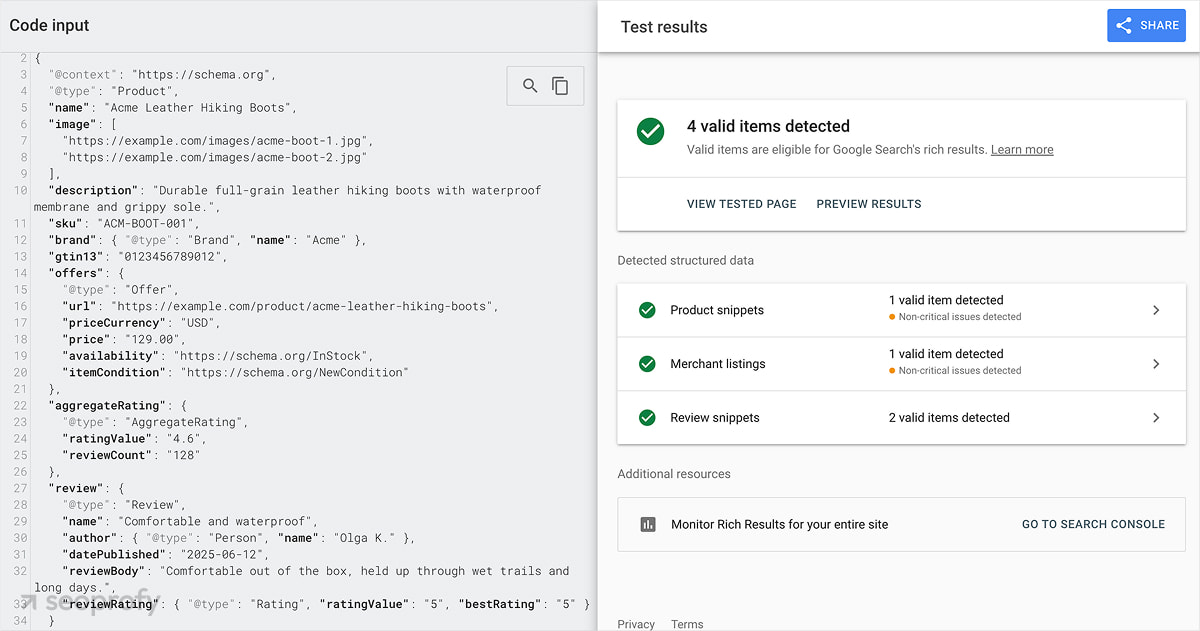
Keep Data Fresh and Accurate
AI engines pull from structured data in real time. If your schema says a product is in stock but it is actually sold out, you risk losing trust signals and visibility (this applies to AIO as well as if you are trying to rank on ChatGPT). Keep price, availability, and rating metadata synchronized with your CMS or product feed. Many brands set this up via automated updates using Google Merchant Center feeds or direct API syncs with their platform.
Treat structured data as a living system, not a one-off setup. Brands that maintain clean, up-to-date schema dramatically improve their chances of getting into AI results and staying there long term.
Monitor and Innovate
Track AI Visibility and Mentions
AI visibility cannot be measured with a single tool. You need to layer different tracking methods to capture the full picture.
|
Tool Category |
Example Tools |
What They Measure |
Why It Matters |
| AI Overview tracking (Google) | Semrush AI Toolkit, Authoritas, Sistrix | Queries that trigger AI Overviews, domains cited, frequency of source rotation | AI Overview results can change several times a day, so monitoring volatility and spotting new competitors early is what you’d want to do |
| Generative engines (ChatGPT, Perplexity, Gemini, Claude) | Aiseo.ai trackers, Ahrefs, Semrush AI Toolkit, Perplexity export, manually scripted prompts | Brand mentions in chat responses, attribution presence, link visibility, and sentiment of responses | These platforms act as alternative search engines. They do help get some visits for your website. However, even without clicks, mentions build trust and brand awareness |
| Classic SERP feature tracking | Semrush Position Tracking, Ahrefs Rank Tracker | Featured snippets, People Also Ask results, and FAQ rich results | Many AI answers are sourced from the same pool as classic SERP snippets. Losing a snippet often means losing AI Overview presence as well |
| Brand and product monitoring | Mention, Talkwalker, Brandwatch, Google Alerts | Mentions of your brand/products across media, forums, and social networks | In AI SEO, external mentions strengthen entity signals a lot and increase the chances of being pulled into LLM-generated answers greatly |
| Log file and analytics analysis | Screaming Frog Log Analyzer, raw server logs, GA4 referrer analysis | Crawl patterns from AI bots (ChatGPT, Anthropic, Perplexity user agents) and unusual traffic sources | Confirms whether your content is being ingested into AI indexes or used in retrieval augmented generation (RAG) |
Build a dedicated KPI dashboard for AI visibility. It should include not just SERP positions but also:
- % of target queries where your brand is ranking in AI Overviews
- Number of monthly mentions in ChatGPT, Perplexity, and Gemini
- CTR vs impressions in AI snippets (visibility without clicks)
- Speed of losing and regaining citations in AI Overviews
Test New Formats and Channels
AI engines are increasingly multimodal. That means ecommerce brands should experiment with:
- Multimodal content: original product images, demo clips, UGC photos, and short-form video all help engines choose your listing because they offer context that plain text lacks.
- Regional landing pages: AI systems adapt answers by geography, so localized product and category pages give you an edge in regional queries.
- Feeds and integrations: keep Google Merchant Center and Microsoft Shopping feeds accurate so AI shopping results display the right products. Watch for new options like ChatGPT merchant feeds since they can expand this reach even further.
Anyway, it all comes down to two things: track with detail and test before your competitors do. Brands that do both end up holding the spots others keep losing.
Final Thoughts
Every member of our team agrees that ecommerce brands cannot afford to ignore traffic from AI-generated answers. However new or fresh these technologies may feel, the AI-powered SEO strategies for ecommerce businesses are already clear. It comes down to teaching AI engines to connect your business with the right entities, structuring content, building mentions that strengthen authority (as important now as traditional ecommerce link building), mining keywords that trigger AI mentions for ecommerce SEO, and not forgetting the fundamentals of classic SEO that still matter just as much.
Sounds complicated? That is exactly why we built a framework to make it manageable. At SeoProfy, we have delivered results across the full spectrum from traditional ecommerce SEO to AI audits and hands-on work that improves visibility in LLMs and AI Overviews. One of our clients, for example, saw traffic surge and orders grow by more than 210% in just a month of ecommerce AI optimization.
Want to see the same growth for your store? Book your strategy call today to optimize your ecommerce website for AI search!


